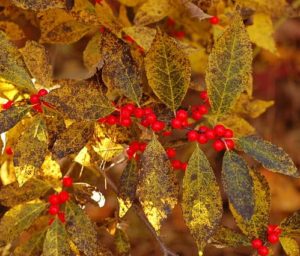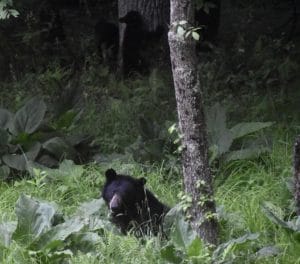Hello fellow readers, While enjoying the respite from gardening, we can relish the winter landscape filled with many treasures. Such as the winter beauty of native Winterberry I came upon along the access road to Camp Mohican in Blairstown, NJ— the red berries brilliant against the dry grasses with the recent snow adding to the radiance. As I jumped out to snap photos, it occurred to me to add these beauties to the property come spring.

‘Winter Red’ Winterberry in Fall
Photo (c)2007 Derek Ramsey (Ram-Man), CC BY-SA 2.5, via Wikimedia Commons
About Adaptable Winterberry
Ilex verticillata is deciduous, giving the berries center stage after losing their leaves. Native all along the east coast and west to Missouri, it grows in low-lying moist woods though you’ll find it on higher, drier grounds too.
Also called Black Elder, Winterberry is an adaptable plant hardy in zones 3 through 9. They thrive in full sun to part shade and moist soil with a pH of 4.5-6.5. And while they’ll sucker, especially in wet conditions, they aren’t invasive, making them ideal for rain gardens. Or as a swath along a woodland edge.
Winterberry’s importance to Wildlife
Birds love the berries once they soften, which is why they remain on the branches well into the winter before our feathered friends have their feast. And while deer may eat the berries too, along with squirrels, raccoons, mice, and rabbits, the plant itself is rated Seldom Severely Damaged by Rutgers University’s Deer Resistant list.
I should note that Winterberry is toxic to humans, dogs, cats, and horses, but only mildly so. But given its importance to wildlife over winter, planting where pets won’t indulge is prudent.

‘Red Sprite’ Winterberry Flowers in Spring
Photo by David J. Stang, CC BY-SA 4.0, via Wikimedia Commons
Cultivars of Winterberry to Consider
The straight species, Ilex verticillata, grows 6 to 10 feet tall and wide, sometimes 15 feet. But there are several cultivars to consider depending on the size plant and the color of the berries you desire.
Check for the suggested pollinator for the Winterberry of choice as you shop. Typically you’ll need one male plant within fifty feet. The key is to be sure the male and female plants flower simultaneously— there are those that flower early and those that flower late.
The Berry Heavy series grows 6 to 8 feet tall and wide, produces more berries than others, and is more tolerant of shade and wet soil. There’s also Berry Heavy Gold should you desire yellow berries. Mr. Poppins is the suggested pollinator that grows 3 to 4 feet. Why not grow his female companion, Berry Poppins too.
Another beauty in the same size category is Little Goblin Orange, with bright orange berries, or Little Goblin Red should you prefer the tried and true. Plant Little Goblin Guy as the pollinator for both.
Red Sprite Winterberry is a favored early-blooming variety slowly growing 3 to 5 feet. One Jim Dandy will pollinate ten Red Sprites.
Legend of Winterberry
I came upon a tune from a long-ago children’s show, Bear in the Big Blue House. The song, Legend of Winterberry, tells of a very hungry bear coming upon one lone berry. Then he sees another bear meandering by.
The lyric— “Come one, come all, come short and tall, sing hi-dee-ho-dee-dairy. And what would you do if it were you with just one Winterberry?”
The hungry bear chooses to share the tiny morsel, and because he did, “when the cold and freezing night, at last, came to an end there were berries blooming everywhere!”
The charming story of sharing despite shortages resulting in abundance is a lesson for all.
Garden Dilemmas? AskMaryStone@gmail.com (and your favorite Podcast App.)
There’s more to the story in the Garden Dilemmas Podcast –
Link to the Legend Of The Winter Berry song
Our beloved Robins feed on Winterberry – You’ll enjoy the story, Robins of Renewal in the Garden.




Once again Mary, you inspire us with another wonderful plant to add to my garden. The Winterberry shrubs while not particularly showy during the growing season, really add so much to our garden in the winter. I love to look out and see the red berries on the branches awaiting the robins and cedar waxwings to arrive and devour them come February and March. I am going to add a couple of ‘Berry Heavy Gold’ to my garden this spring…Thank you for all the great information!
Hello April, Thank you for your kind words. I agree Winterberry gets lost in the shuffle during the growing season, likely why I never planted them here. I’ll be right behind you at the nursery :^)